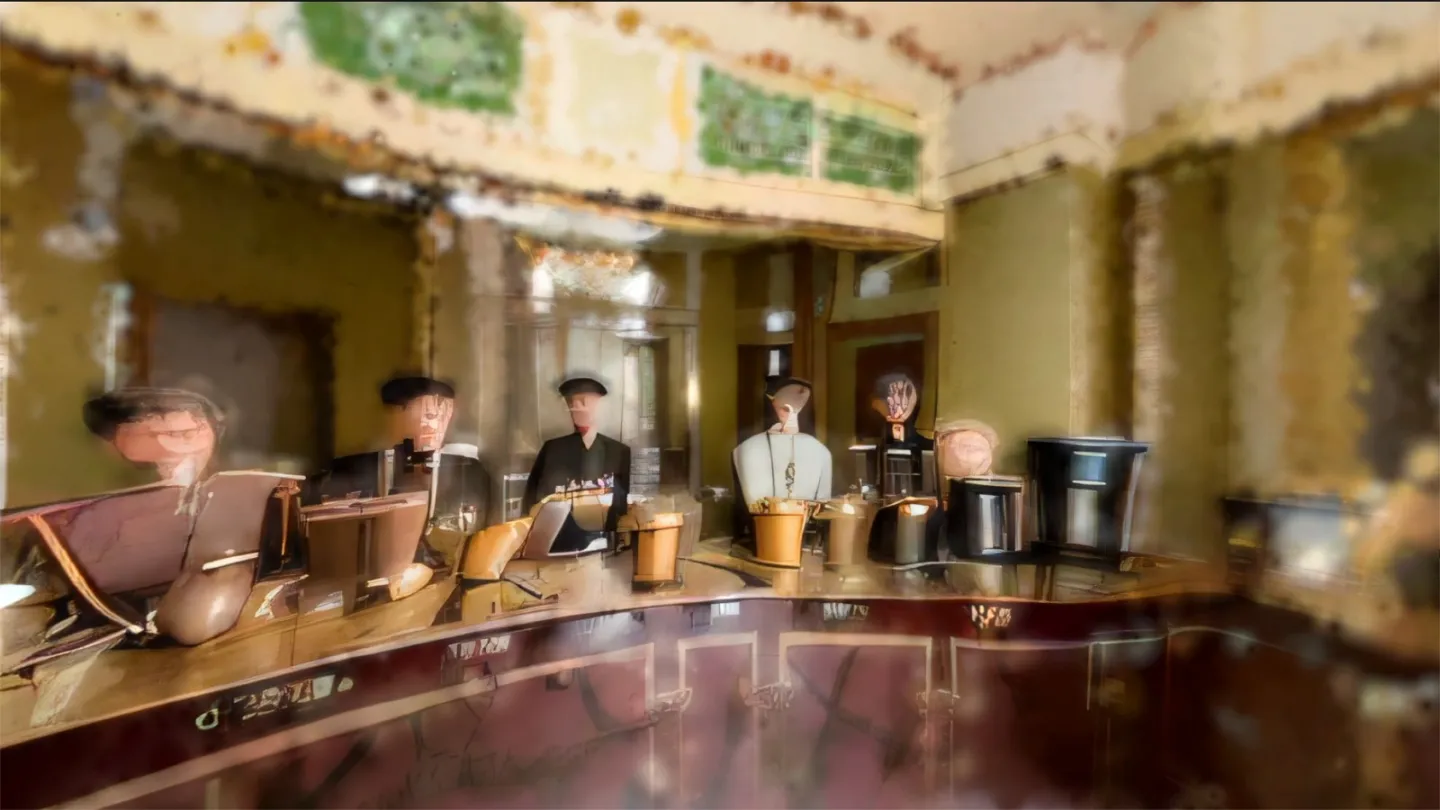Tulpamancer
“For a very long time I would check the Turing test every single year and see what was new out there and suddenly it’s just, we’ve gone way past it and we’re able to model these encounters with these large-scale machine learning models that are spooky in action and foreshadowing a lot of what is to come.”
—Matthew Niederhauser, on the Voices of VR podcast
Tulpamancer is a machine learning VR installation that creates a dreamlike encounter with the memories and possible futures of each participant. Sitting down at a computer terminal that had lain forgotten in a warehouse since 1989, participants first encounter the tulpa through a series of questions about their own lives. They are then invited to meet in a world prepared uniquely for them. Participants put on a VR headset and are led on a journey by their tulpa through a series of uniquely generated virtual scenes that invoke and question the memories of their own past and their potential fates. Every interaction produces a unique work that is deleted at the conclusion of its viewing, left only to resonate in the minds of each participant.
CREATORS’ STATEMENT
What does it mean to share your life with a machine? The tulpa—an idea rooted in Tibetan Buddhism but popularized by the theosophical thinker Annie Bessant (1847-1933)— refers to the physical manifestation of thought through spiritual practice and intense concentration. A transformation in society now appears to loom with the emergence of AI, a technology that derives its power by concentrating intensely on enormous volumes of online text and images—the digital traces of our collective unconscious. The tulpa was a way of making sense of and providing alternative frames for modernity. This work thus provides participants an occasion to explore alternative histories and futures for AI.
ABOUT TULPAS AND TULPAMANCY
“Tulpas, a term reportedly borrowed from Tibetan Buddhism, are imaginary companions who are said to have achieved full sentience after being conjured through ‘thought-form’ meditative practice. Human ‘hosts’, or tulpamancers, mediate their practice through open-ended how-to guides and discussion forums on the Internet and experience their Tulpas as semi-permanent auditory and somatic hallucinations.
Origins
“The term Tulpa began circulating in the West in 1929 following the publication of Magic and Mystery in Tibet [Mystiques et magiciens du Tibet] by the Belgian-French explorer Alexandra David-Néel. The author, who reported observing the practice in Tibet, claimed to have created a Tulpa of her own in the image of Friar Tuck. Often fully transcribed as sprul pa’i sku from the Tibetan སྤྲུལ་པ, the term can be translated as ‘emanation’ or ‘incarnation’, and is associated with the physical body (Nirmanakaya). A Tulpa, as presently understood in the tulpamancer community, is a sentient being who becomes incarnate, or embodied through thought-form.
Tulpas and the senses
“Drawn from primarily urban, middle class, Euro-American adolescent and young adult demographics, most Tulpamancers cite loneliness and social anxiety as an incentive to pick up the practice and report overwhelmingly positive changes in their individual and offline social lives, in addition to an array of new, ‘unusual’, but largely positive sensory experiences. These include (in order of frequency) auditory, tactile, visual, and olfactory sensations. “Raw thought”, “intuitive thinking”, “speaking with no words” and “communicating with images, feelings and music” are also reported along with other non-verbal, non-narrative forms of interaction. . . .
Tulpa folk theory
“The community is primarily divided between so-called psychological and metaphysical explanatory principles. In the psychological community, neuroscience (or folk neuroscience) is the explanation of choice. Tulpas are understood as mental constructs that have achieved sentience. The metaphysical explanation holds that Tulpas are agents of supernatural origins that exist outside the hosts’ minds, and who come to communicate with them. Of 118 respondents queried on the question, 76.5% identified with the psychological explanation, 8.5% with the metaphysical, and 14% with a variety of “other” explanations, such as a mixture of psychological and metaphysical.
“Several Tulpamancers (from both psychological and metaphysical communities) report having had sentient imaginary friends for up to several years before finding out about Tulpamancy. For one informant, the practice had been established in her family for several generations. Many Tulpas from the psychological tradition, when interviewed separately from their hosts, also claim to have ‘been around’ in their hosts’ consciousness before their hosts became aware of them through Tulpamancy.
“Of 73 Tulpamancers tested on this question, 37% reported that their Tulpas felt “as real as a physical person”, while 50.6 % described their mental companions as “somewhat real – distinct from physical persons, but distinct from [their] own thoughts”. 4.6% claimed “extremely real” phenomena, where Tulpas were “indistinguisable from any other agent or person”. Only those 4.6% claimed to hear and see their Tulpas “outside” their heads. The median length of Tulpamancy experience for these respondents was one year. Tulpamancers with 2+ years of experience reported higher degrees of somatic experience. . . .”
—Samuel Veissière, “Varieties of Tulpa Experiences: Sentient Imaginary Friends, Embodied Joint Attention, and Hypnotic Sociality in a Wired World,” Somatosphere, April 3, 2015
Samuel Veissière is assistant professor of anthropology at the University College of the North and a visiting professorship in the Culture, Mind, and Brain program at McGill University, where he is affiliated with the Division of Social and Transcultural Psychiatry and the Department of Anthropology.
 Marc Da Costa is an anthropologist whose work involves data and archives and the way they influence our relationship with the world and with one another. His academic work has explored these themes through studies of placemaking practices in the Anthropocene, with particular focus on Antarctic research expeditions and critical cartography. His artistic research examines how data and technical infrastructures focus our attention on the world in particular ways and, in so doing, shape the structures of experience available to us. Throughout his work he is animated by an interest in the historical, political and ecological stakes of human life on a small rock in a very old universe.
Marc Da Costa is an anthropologist whose work involves data and archives and the way they influence our relationship with the world and with one another. His academic work has explored these themes through studies of placemaking practices in the Anthropocene, with particular focus on Antarctic research expeditions and critical cartography. His artistic research examines how data and technical infrastructures focus our attention on the world in particular ways and, in so doing, shape the structures of experience available to us. Throughout his work he is animated by an interest in the historical, political and ecological stakes of human life on a small rock in a very old universe.
Marc holds a Ph.D. in cultural anthropology from the University of California, where his research focused on Antarctic research expeditions and the role of cartography in shaping our understanding of anthropogenic climate change. He is a cofounder of Enigma Technologies, a New York-based company that provides comprehensive intelligence about the identity and financial health of small and medium businesses across the United States. His essays on technology, data and society have appeared in The Guardian, New York magazine, The New York Times and elsewhere. As a fellow at the Columbia Journalism School’s Brown Institute for Media Innovation, he collaborates with investigative journalists to develop new approaches to data-driven storytelling. He also serves on the advisory boards of the Harmony Institute In New York and the Center for Ethics, Society, and Computing at the University of Michigan.
 Matthew Niederhauser is an artist, photojournalist, and educator. His latest work pushes the limits of emerging interactive and immersive technologies within a wide range of media, including virtual reality, installation and video. He has taught immersive storytelling and virtual production at New York University’s Tisch School of the Arts and Tandon School of Engineering. Previously he studied anthropology at Columbia University and worked on longterm documentary projects across China. This work was supported by the Pulitzer Foundation and featured in such publications as The New Republic, The New York Times, The New Yorker and Wired. During this time he also published Sound Kapital, a collection of portraits exploring China’s underground music scene.
Matthew Niederhauser is an artist, photojournalist, and educator. His latest work pushes the limits of emerging interactive and immersive technologies within a wide range of media, including virtual reality, installation and video. He has taught immersive storytelling and virtual production at New York University’s Tisch School of the Arts and Tandon School of Engineering. Previously he studied anthropology at Columbia University and worked on longterm documentary projects across China. This work was supported by the Pulitzer Foundation and featured in such publications as The New Republic, The New York Times, The New Yorker and Wired. During this time he also published Sound Kapital, a collection of portraits exploring China’s underground music scene.
Matthew earned his MFA in Art Practice and Theory from the School of Visual Arts while also a visiting scholar at the MIT Center for Advanced Urbanism, a visiting artist at the MIT Center for Art, Science, and Technology, and a member of New Museum’s art incubator, New Inc. At New Inc. he and a fellow member, John Fitzgerald, founded Sensorium, an experiential studio working at the forefront of immersive storytelling, with projects premiering at Venice Immersive, Sundance New Frontier, Tribeca Immersive, and IDFA DocLab. He continues to develop new projects both independently and with Sensorium while also acting as technical director at Onassis ONX Studio, an XR production studio and exhibition space in midtown Manhattan.
IN THE MEDIA
“One of the hottest tickets at the 80th Venice film festival isn’t a movie at all but a VR installation on the event’s self-styled ‘Immersive Island.’ Each user sits at a computer and answers a series of personal questions, which the exhibit – in the space of a few seconds – converts into a bespoke portrait of their life. . . . Some come out tearful and joyous. Others, though, emerge disconcerted and disturbed. Such a breadth of response has made Tulpamancer one of the hits of this year’s festival. But it also reflects our own ambivalence towards generative AI, our fraught relationship with a technology that takes its lead from both the best and worst of humanity.”
—The Guardian



